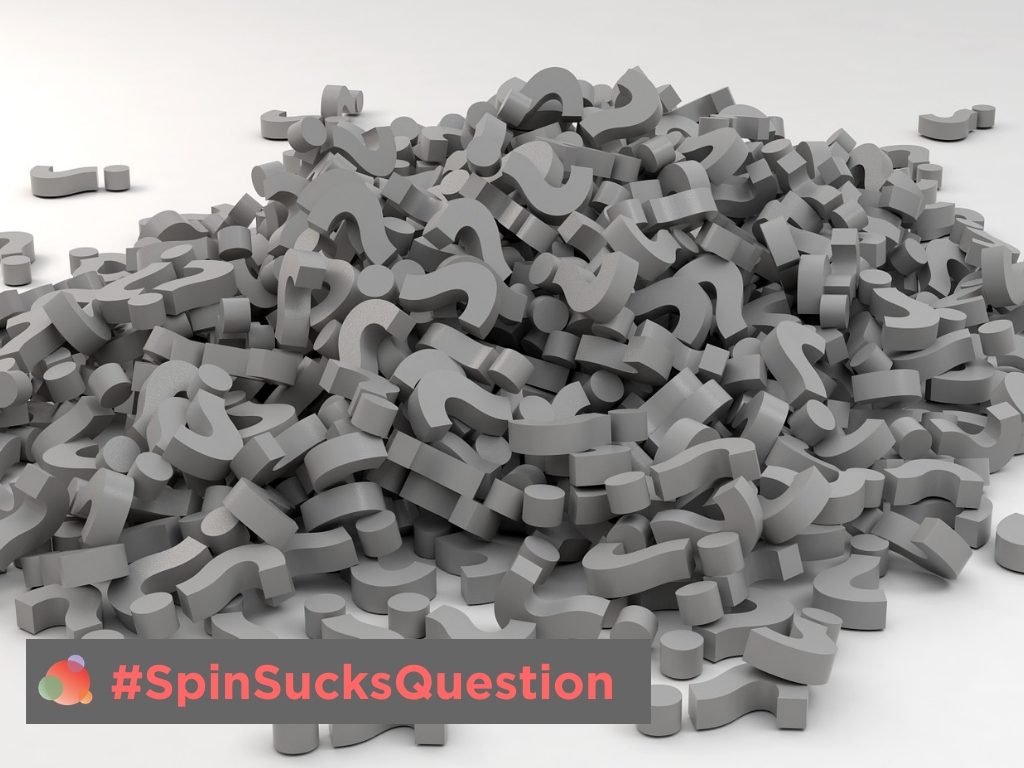 I’m not very creative when it comes to emoji.
I’m not very creative when it comes to emoji.
I have two or three that are my go-to’s but that’s it.
These days, I use the crying laughing face instead of LOL, and I use the facepalm girl quite a bit.
Other than that, I might toss in a thumbs up or the skeptical face, but that’s about it.
Maybe it’s a generational thing, but I don’t love them. (Don’t even get me started on Bitmoji… LOATHE.)
However, I know plenty of people who do.
We actually came across an interesting article about the world’s most used emoji.
It’s the crying laughing face.
So we decided that might be an interesting topic for the #SpinSucksQuestion.
(Side note: There was actually a debate on the correct way to pronounce the plural version of “emoji”. But since AP Style decided it shouldn’t have an “s” at the end, we went with that.)
This week, we asked:
“What’s your most used emoji and what do you use it to convey?”
And our community was more than visually creative with their answers.
A Big Thumbs Up
Surprisingly, and despite what the data says, we didn’t have many people say they used the crying laughing emoji.
There was a handful but a lot of responses included the thumbs-up.
I use the thumbs up waaaaay to much.
There’s a good chance I also use it too much in real life, which may be why it’s spilled over into my preferred emoji use.
The thumbs up is my go-to. But I want to be more creative in my emoji use so I’ve been trying to switch to the smiley-bowtie-guy (which kinda, sorta says the same thing). Still, my thumbs up habit is hard to break.
Professional use: thumbs-up. Personal use? I go with the eye rolling emoji and the crying laughing face.
I almost never use them except in Slack, and then it’s generally applause, thumbs-up, party, or fireworks.
You Laugh, You Cry, You Roll Your Eyes
Inside work I don’t, but personally, the emoji depends on the person I’m speaking with. A handful of friends always get the facepalm girl because … why are you like this?
Outside of those, it’s usually the cry laughing face because either the conversation is good or, in most cases, I crack myself up.
I use the starry-eyed one the most. It’s like my emoji version of exclamation marks, which I overuse excessively (repetitive phrasing intentional).
I don’t use them for work, because I feel they decrease professionalism in online communications. You can express great sentiment via words, as we have for centuries.
Personally, I use the expressionless face the most (which admittedly isn’t often):
Why? Because my friends make terrible jokes a lot.
But it was Christopher S. Penn who pointed out how emoji can change the tone of a sentence:
Emoji are nothing more than Unicode character strings like “\xf0\x9f\x98\x80” under the hood. What I find fascinating about them, and have on my list of things to do, is tie them into sentiment analysis to see how they correlate to the sentiment of the surrounding text.
Christopher also shared a link to a post he wrote about how emoji can be considered as ideograms, and like all his content, it’s worth the read.
Interpretive Emoji
And here lies the (emoji) rub.
Emoji can be interpreted in so many different ways you run the risk of sending the wrong message.
By a show of hands, who here has had an older relative or friend use LOL in an online post and thought it meant “lots of love” instead of “laughing out loud?”
I haven’t myself, but there are constant examples of this on the Old People Facebook subreddit.
Half of the time, the LOL will be in response to someone posting funeral arrangements or the like.
This is similar to the way we use emoji, in my opinion.
Granted, a lot of them are pretty straightforward.
But take the expressionless face.
I use it as a way to convey: “Are you being a serious person right now?”
Others might use it as a way of being—well—expressionless.
Of course, messing something like that up in a personal text message with a friend can be quickly solved with a reply to explain.
Using an emoji in a marketing campaign and messing up, can be a fair bit trickier to handle.
How Do You Use Emoji?
There’s no right or wrong way to use emoji.
And there isn’t any one person who has the definitive answer on the “correct” way.
How do you use them?
Are you an all-emoji-all-the-time kind of person?
Or do you think they’re silly and that we’re essentially reverting back to using hieroglyphics?
We ask a #SpinSucksQuestion every week and if you want to become more involved in our community, the door is always open to our Slack group.
You can find the form to register here.
And now … the comments are yours.